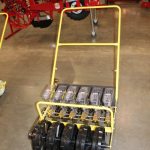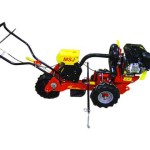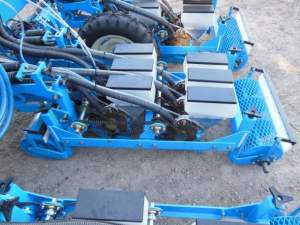Trends In Tractors And Planters: Maximize Your ROI
You want to get the job done quickly and accurately. So your tractors and planters need to be easy to operate and capable of withstanding various environmental conditions in the field. You also want machinery that will reduce the need for labor.
As costs continue to rise, you need equipment that allows you to produce a crop in the most efficient way possible.
American Vegetable Grower caught up with growers and equipment suppliers to learn about the latest trends as well as what you should look for when choosing equipment.
We also asked suppliers to share information on some of their latest tractors and planters.
TRACTORS
When asked about the most important attributes he looks for in planting equipment and tractors, Greg Lewis, production manager for Duda Farm Fresh Foods, Inc. in Oxnard, CA, says he looks for safety, the quality of work performed, and cost of operation.
“The safety of the [equipment] operators and our people in the fields around the machines is of utmost importance,” he says. “There should be very little doubt that without the good health of our people, quality work does not get accomplished. Placing operators in safe equipment gives them the confidence to get the job done.”
In addition to safety, an immediate concern for those looking for tractors is making sure the unit is in compliance with emission standards. With the tiered system of emissions reductions that began in 1996, Final Tier 4/Stage IV regulations, which are slated to be fully implemented this year, are to maintain levels of particulate matter and require an approximate 80% reduction in nitrogen oxides compared to Interim Tier 4/Stage III B, according to John Deere. (For more information from Deere on emissions, go to http://bit.ly/1CcrHqu.)
Brad Aldridge, product marketing manager at John Deere, says one of the biggest trends in tractors in the last few years centers around reduced exhaust emissions regulations as the industry has moved from Tier 3 to interim Tier 4 and now to Final Tier 4 regulations.
“John Deere has invested to not only meet these regulation levels, but also to deliver additional customer value with the introduction of the new products,” Aldridge says. “As with many crops today, controlling input cost is critical to the grower’s bottom line.”
Scott Hessel, John Deere’s product marketing manager for mid-size tractors and loaders, agrees that regulations are top of mind for growers. He says the company has equipment and solutions to help meet some of these concerns, from bio hydraulic fluid for environmentally sensitive areas to technology that will document chemicals applied and weather conditions.
In December 2014, John Deere introduced its new Final Tier 4 compliant 5100MH Hi Crop utility tractor, which features new 230/95R48 front and rear tires for increased crop clearance. (See New Tier 4 Tractor sidebar for more details.)
Horsepower Needs
Tractor horsepower is also top of mind. According to Martin Cisneros, marketing communications manager at Mahindra USA, Inc., his company has been receiving requests for higher horsepower units as well as for manufacturers to handle seasonal operations with rental or lease programs that are flexible enough to meet operators’ payment schedules.
“Vegetable growers are looking for products that will provide them with versatility, dependability, and with a list of available options, attachments, and implements to meet their varied needs,” Cisneros adds.
In fact, when you are looking to buy a tractor, Chris Drew, production manager at Sea Mist/Ocean Mist Farms in Castroville, CA, recommends to first “size” the tractor for the jobs it will be required to do.
“People will buy a tractor for primary tillage and they may not size the horsepower properly,” he explains. “If you have fields that require ‘X’ amount of horsepower, it is essential that you buy enough horsepower for what you are trying to achieve. If you don’t, what you will end up having to do is operate your tractor at a higher RPM than needed to properly pull an implement. Higher RPM’s are directly correlated to higher fuel consumption, the more fuel you burn the more money you spend — money that could have been spent on a higher horsepower tractor. Properly sizing a tractor can save a grower money in the long run.
PLANTERS
Labor is an ongoing concern in many aspects of agriculture, especially for California growers who will be paying more for their collective workforce next year. Beginning Jan. 1, 2016, the minimum wage in the Golden State will be $10 per hour.
As a result, labor shortages and wage increases have made uniform seed spacing, in particular, more important, says David Fountain at Solex Corp., a supplier of planting equipment. When using hand labor, workers can thin faster when plants are spaced evenly.
“Growers are now looking for planters that can stagger or synchronize the seeds from one line of crop to the adjoining line of crop,” he says. “This is being tested by electric motors driving each metering unit of the planter.”
Chemical and mechanical thinners along with mechanical weeders also have created a need for more uniform plant spacing, Fountain says. The result is fully automatic transplanters are gaining attention.
“A mechanical transplanter [can use] as many as 14 workers per planter,” Fountain explains. “Some of the fully automatic transplanters are doing the same job with
three workers.”
Precision Counts
Getting it right the first time also will help save on labor costs. That’s why Sea Mist/Ocean Mist Farms’ Drew says GPS capabilities are becoming a necessity. The cost of seed has increased, so precise placement of seed plays a major role in profitability, he says.
“In the past, we would plant every 2 or 3 inches and
out more than double the seed per acre that we actually needed to,” he explains. “The cost of seed and the genetics that goes into producing that seed has increased every year. As a result, we look for GPS capabilities that will run the planter off a calculated formula.”
Drew also encourages growers to also pay attention to the costs associated with maintaining the planter as that, too, will impact your bottom line.
“The planter does one of the most important jobs on the farm: It plants the seed to specifications you have for that specific commodity,” he says. “If something is not maintained properly or it is not doing the job, it could impact your yields out of the gate.”
Grower Needs
In the end these developments in equipment are all about growing a great crop in the most efficient manner possible. According to Lewis, Duda Farm Fresh Foods is committed to delivering high-quality product to its customers while making fewer passes through the field.
“Few farmers around the globe are able to do with an acre of land what American farmers do,” Lewis says. “The costs of rent, labor, crop protection materials, diesel, and fertilizers continue to rise. Yet the cost at the supermarket shelf is not commensurate with ever-increasing growing costs. So we do more with less. American farmers are able to continue to provide to the retailers the highest quality produce at incredibly high volumes because of precision.”
New Tier 4 Tractor
John Deere introduced a new Final Tier 4-compliant tractor for specialty growers in December 2014. The tractor, 5100MH Hi Crop utility tractor, features a low-sloping front hood for increased forward visibility, new 230/95R48 front and rear tires for increased crop clearance, and 4% power bulge and 30% torque rise for optimum performance in tough field conditions.
 It also features stackable selective control valves (SCV) for easy field conversion from dual to triple SCVs and optional LED work lights to enhance visibility in low-light conditions.
It also features stackable selective control valves (SCV) for easy field conversion from dual to triple SCVs and optional LED work lights to enhance visibility in low-light conditions.
For the driver, the tractor offers a cab with an enhanced sound system, plus a high-back, heated-seat option with low-frequency air suspension
for improved field ride quality and more comfort on cold days.
For more information, go to Deere.com.
Planting Needs Of Small Farms
Labor and wages are a concern for all growers, but some small to mid-size growers — operations with 5 to 200 acres who often do the planting themselves — are focused on efficiency, says Dan Timmer of Mechanical Transplanter.
For example, Timmer has some customers with 5 acres who will buy a $2,000 machine, and others who will purchase an $8,000 transplanter.
 “It all depends on how efficient they want to be and if they want to [transplant] with one person or if they want to do it with two or three people,” he says.
“It all depends on how efficient they want to be and if they want to [transplant] with one person or if they want to do it with two or three people,” he says.
Another option for small growers is the hand seeder. Mechanical Transplanter distributes units from Korea-based Jang Automation that are available with one, three, and six-rows.
“For the price of the seeders [a six-row is about $2,000], they do a nice job of singulation,” Timmer says. “Plus, the size of the seeder makes it good for high tunnels,” he says.
For more information, go to MechanicalTransplanter.com.
Vacuum Seed Planter
 The new PushMacc MSJ is a one-row hand-controlled vacuum seed planter that plants all size seed from carrot to pumpkin — one seed at a time. The vacuum is created by a Briggs & Stratton gasoline engine that also propels the planter forward.
The new PushMacc MSJ is a one-row hand-controlled vacuum seed planter that plants all size seed from carrot to pumpkin — one seed at a time. The vacuum is created by a Briggs & Stratton gasoline engine that also propels the planter forward.
Market Farm Implement specializes in vegetable crop machinery from tillage to harvest.
Contact Market Farm Implement at 814-443-1931, or go to www.marketfarm.com.
MS Version M, Multi-Line Bed Planter

Monosem’s MS version M Multi-line planter uses the MS precision vacuum metering system to accuracy plant extremely small raw and pelleted seeds.
Since the initial development of the Monosem MS Mini-Seed planter in 1995, Monosem has continued to offer updated configurations of the MS planter to meet the changing demands of specialty growers. Monosem’s latest development in small-seed planting, the MS version M Multi-line planter, uses the MS precision vacuum metering system that growers have come to rely on to accurately plant extremely small raw and pelleted seeds.
The new configuration offers multiple vacuum meters and shoes mounted on a square cross rail inside a frame that corresponds to the grower’s bed width. The cross rail permits the precise alignment of multiple meters on one frame as well as a simple adjustment of the meter location for a wide range of seed line spacings. The planter is a perfect fit for growers who plant multiple vegetable crops and want the ability to easily change the distance between seed lines and the number of seed lines per bed.
To accommodate for varying field and soil conditions, the parallel linkage design of the frame section permits infinite adjustment to the amount of weight on the bed. This flexibility ensures the multi-line frame will float on the bed and the rollers will not compact or flatten out the bed during planting.
Both the front and the rear rollers control planting depth; this balanced depth design ensures a more consistent planting depth on uneven beds. The roller height is set with a crank handle that is connected to each corner of the bed frame. Screw adjust drive wheels give the planter even more flexibility because they allow it to plant on both flat ground or raised beds.
The new configuration was specifically designed for high density planting on beds with seed lines as close as 1 inch apart across the bed top. The Monosem precision meter allows high population crops, like leafy greens, to be planted to a stand without excessive seed use.
The Monosem precision meter allows high population crops, like leafy greens, to be planted to a stand without excessive seed use.
The Monosem precision meter allows high population crops, like leafy greens, to be planted to a stand without excessive seed use.
Three standard bed widths are available:
- 40-inch bed width with 24.5-inch bed top; eight seed lines available with single shoe or 10 lines with 2-inch split shoes.
- 60-inch bed width with 44.5-inch bed top; 16 seed lines available with single shoe or 20 lines with 2-inch split shoes.
- 80-inch bed width with 64.5-inch bed top; 23 seed lines available with single shoe or 30 lines with 2-inch split shoes.For more information, go to www.monosem-inc.com.









